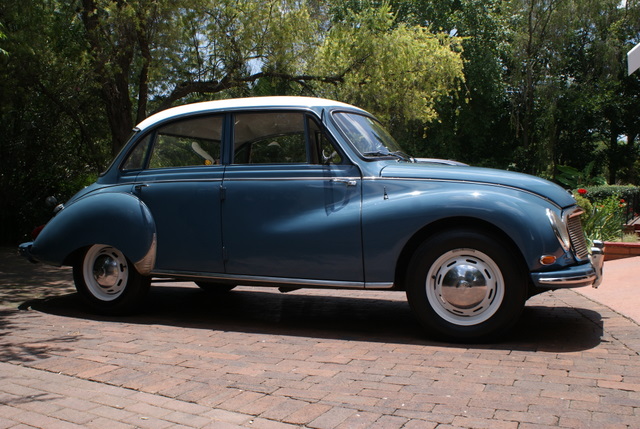
The Japanese Bike Show organised a ride for two-stroke bikes on Saturday 26 November 2011. The Blue Haze Ride started at Burswood Casino carpark at 9am before heading off to the E-Shed Markets Fremantle, where the bikes were displayed as part of the Fremantle Festival.

The Ariel on arrival - for once I was mostly on time! A photo by Graelin.


Although organised by the Japanese Bike Show it was open to all two-strokes regardless of origin. It was great to see some 'oddities' out there. This is a 1972 Jawa Californian from Czechoslovakia. Jawa built the Californian with the export market in mind to bring in much needed hard currency.

A Kawasaki 750 triple and a range of modern two-strokes.

1970s Yamaha and Suzuki.

A trio of Yamaha's. Yamaha's two-stroke range started in 1955 with the YA-1, a copy of DKW's pre-war RT125 motorcycle - the most copied motorcycle in the world.
http://heinkelscooter.blogspot.com/2010/04/das-kleine-wunder-story-of-remarkable.html


Very modern two-stroke sports bikes, including an Aprilla.

I'm not a great fan of modern bikes but I must admit this 1985 Suzuki is pretty damned stylish. If I had to.....

A BMW R80/7. Well, not really a two-stoke, so that probably explains why it was parked in a corner.

The group sets off. A photo by Graelin.

Photo by Graelin.

The main pack arrives at the E-Shed. Typically I lost my way on the ride (too slow, wrong freeway exit) so I arrived slightly before the main group, which allowed me to snap a couple of pics as they drove. The scream of the two-stroke engines was quite wonderful.

A photo by Graelin.

The pack settles in




As I'd arrived slightly earlier than most I parked in the E-Shed motorcycle bays. Why is there always so little motorcycle parking in Perth? The E-Shed is a popular coffee stop for motorcyclists on a Fremantle run but there are only about 10 bays (quite a lot really) awkwardly spaced around a large transformer box. I'm guessing that if the transformer box wasn't there there would actually be NO motorcycle parking there at all.

Some bikes were trailered in specially. Ray and Anne bought down their collection of British lightweight two-strokes.

Ray poses with his collection.

A 1952 BSA Bantam D-1, a 1954 James Cadet and a 1954 Francis-Barnett.

Probably the most successful British motorcycle of all time. Other British motorcycles may be more famous, more powerful, and more expensive, but the Bantam was THE bike almost everyone of a certain age first learned to ride on. The Bantam of course was the British version of the German DKW RT125.

I moved the Ariel around to join its English brethren.

The English contingent certainly drew a crowd. I was quite surprised by the number of English gents who suddenly appeared with that nostalgic look in their eye saying, "I first learned to ride on a Bantam when I was 14..." There were dozens of them and it was great to hear all their stories. I had a good chat with a fellow who did his mechanic's apprenticeship at BSA in Birmingham. He had lived half way between the BSA factory and the Francis-Barnett/James factory but went with BSA as he had more opportunity to learn from them as BSA at least built their own engines. F-B and James used Villiers engines. He'd owned a Bantam, a Gold Star (which he didn't like) and a Leader at various times.

Photographing the James

An immaculately restored 1974 Kawasaki 750. It was for sale for $19K.

Chris' 1986 MZ ETZ250 was a latecomer to the show but it certainly drew a bit of attention. Two English guys instantly recognised it and came over for a chat. The East German
eisen-schwein (iron-pig) was built at the old DKW works at Zchopau by MZ (Motorradwerke Zchopau) and exported all over the Eastern Bloc and - surprisingly - the UK. In the UK they were dirt cheap and almost became the BSA Bantam of a later generation. MZs certainly weren't flashy bikes but they could tolerate abuse and neglect and just keep going.


Another Czech Jawa. This one is roughly 1968-70. It's been restored with a mix of parts. Still looks beautiful though. The similarity with a DKW is obvious.

Looking over the crowd at about 12pm. I think it was a good turn out and there was a lot of interest from passersby's. There was good chat and discussion amongst all the riders, regardless of what they were riding. Good work Mike and the team for arranging the ride.
http://www.japbikeshow.com.au/intro.htm It was a great day!

At about 1pm the crowd began to move off. Ben hops on his beautifully restored 1970 Jawa.

I tend to think of this as an 'old bike' problem, but no. One of the riders gets a helping hand with a push start. We shouldn't laugh as it's happened to all of us. As it turned out I was almost the last bike away. When I moved the bike to join the English contingent I forgot to turn off the petrol tap and the engine was flooded (note to self - DON'T FORGET TO TURN OFF THE PETROL TAP - AGAIN!). It needed a good half an hour to rest before it kicked over again. Thanks to Simon from Perth Street Bikes for helping try to start it with me.

The Endeavour replica was in port too so I popped over to have a look. I was only stopping for a minute to have look but another two groups of English tourists came over to ask, "Isn't that an Ariel?" Happy days!























































